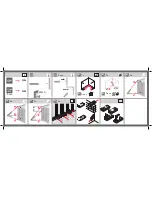
AMI Analyzer Manual
Analyzer Description
24
Analyzer operation
It is just as important that the analyzer’s sample system – the components used to control the gas flow – are
perfect as the measurement methodology itself. No matter how good the analyzer is, if you don’t connect
the plumbing correctly you won’t get good results.
Sample tubing and components
For percent level readings, high quality plastic tubing is acceptable but in industrial environments stainless
steel is generally preferable. Do not use silicone tubing – the very soft milky material. It is extremely
diffusive and will give incorrect readings. Use high quality compression fittings such as “Swagelock™” or
“Gyrolock™” and high quality stainless steel filters, valves or regulators if necessary. Make sure that they
are assembled correctly and perform a thorough leak test on the sample system before use.
The analyzer expects to see sample pressures between about 1 psig and 150psig. Higher pressures will
overwhelm the input valve and make it hard to control the flow. If your pressure is higher than this use a
regulator with a stainless steel diaphragm to bring the pressure down appropriately. The analyzer is not
very much affected by changes in flow rate and the internal flow meter is adequate for setting the flow.
The span gas pressure should also be held below 100psig. AMI recommends that you use a length of their
flexible tubing with O ring seals on its fittings so that you don’t damage the analyzer fittings by making and
breaking them too often.
Exhaust
The exhaust port of the analyzer should be given at least a foot of tubing, but it should not be allowed to
become pressurized, or the readings will be affected. It should be vented outdoors or brought into a
scavenging system. If the latter, have the scavenging system suck in room air around the exhaust line so
that the pressure at the exhaust is atmospheric. A typical way of doing this is to have the scavenging system
suck on a 1” pipe, and have the ¼” exhaust line from the analyzer extend six inches or so into the end of the
pipe.
Calibrating the analyzer
The oxygen sensor gradually gets used up over its life, and as it does so its sensitivity slowly drops until it is
at the end of its life, when the sensitivity drops much faster. Therefore you have to calibrate the sensor
every so often to make sure that your readings are correct.
There are two ways of doing this. You can use a span gas, a mixed gas containing a certain level of oxygen in
a background gas that ideally matches your sample, but in practice is normally nitrogen, or you can use air.
The advantage of using air is that its value really is 20.9% and it doesn’t change (except minimally due to
humidity changes).
The advantage of using a span gas is that you can calibrate it to a value close to the range of interest. You
may have political reasons for having to do this. The disadvantage is that span gases sometimes are
incorrectly made, and they can be contaminated by improper handling.
Содержание 210BR
Страница 1: ...08 31 2018 Made in the USA AMI Oxygen Analyzer Manual Model 210BR Costa Mesa CA ...
Страница 2: ...AMI Analyzer Manual Contents i ...
Страница 16: ...AMI Analyzer Manual Installation Procedure 13 ...
Страница 24: ...AMI Analyzer Manual Analyzer Description 21 Drawings Figure 7 Outline Drawing Figure 8 Flow schematic ...
Страница 25: ...AMI Analyzer Manual Analyzer Description 22 Figure 9 Control drawing AC unit Figure 10 Control drawing DC unit ...
















































